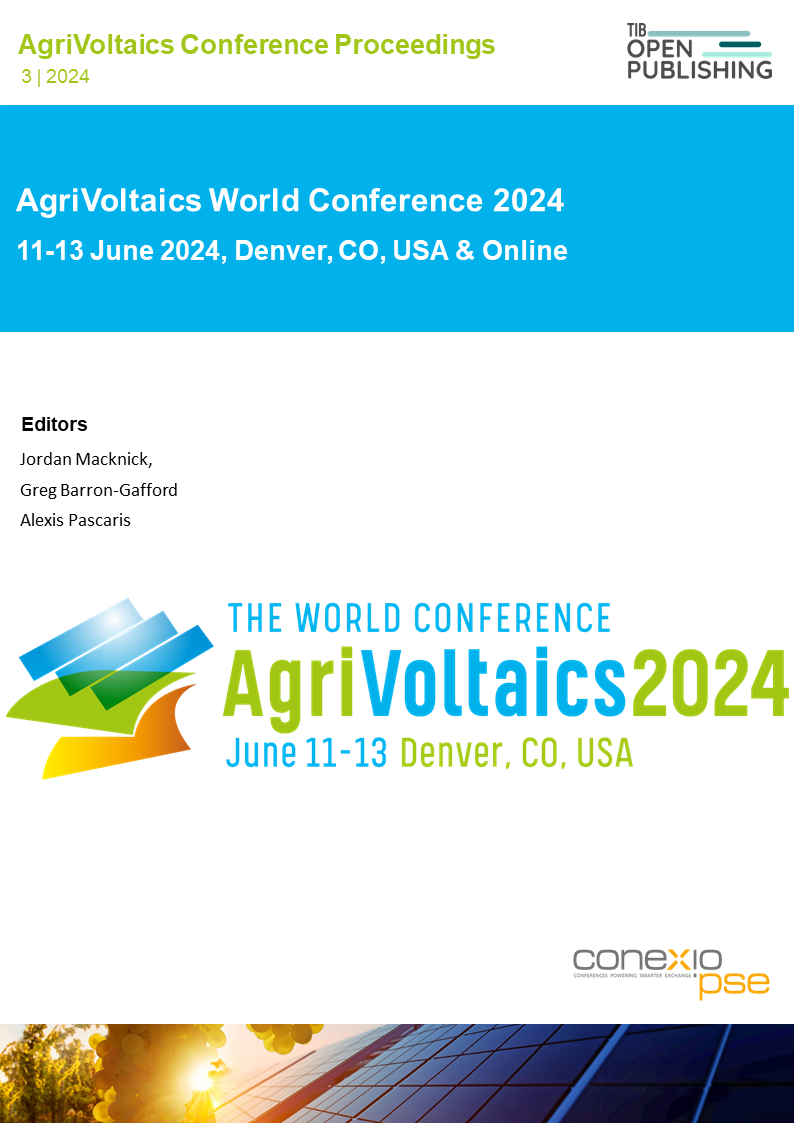Transforming Risk Perception and Fostering Cooperatively the Agri- PhotoVoltaics Technology With Farmers in Five Countries
A Sociological Perspective From the REGACE (Crop Responsive Greenhouse Agriphotovoltaics System With CO2 Enrichment for Higher Yields) Project
DOI:
https://doi.org/10.52825/agripv.v3i.1386Keywords:
Agrivi Photovoltaics, Farmers Participation, Technology Co-DesignAbstract
The interaction between agricultural practitioners and innovative technologies has emerged as a critical area of inquiry in contemporary academic discourse. Disruptive advancements in agricultural technology—particularly in the domains of drone applications, artificial intelligence (AI), and agrivoltaics—present significant potential to address urgent environmental and energy-related challenges. However, the successful adoption and integration of these technologies are contingent upon robust processes of societal acceptance and comprehension, especially among farmers, who constitute the primary users and key stakeholders. The theory of disruptive innovation, initially conceptualized by Bower and Christensen in 1995, underscores the transformative capacity of novel technologies across various sectors. Nevertheless, the efficacy of such innovations is predicated on their seamless integration and acceptance by diverse stakeholder groups, including primary actors such as farmers and industry, as well as secondary entities with ancillary interests. For technological innovations to achieve their intended outcomes, they must be accompanied by authentic participatory processes that involve end-users from the initial stages. Within this framework, next-generation agriphotovoltaics greenhouses—which integrate photovoltaic systems with agricultural practices and enhance soil CO₂ enrichment—represent a pivotal solution for reconciling agricultural productivity with renewable energy generation. The WP6 of Regace Project. In this perspective, the WP6 of the REGACE project aimed, through the use of mixed qualitative, quantitative, and participatory methodologies, to investigate farming communities’ perceptions of agriphotovoltaics innovations. These sociological processes are intended to accompany the phases and models of agriphotovoltaics innovation from a perspective of social sustainability, with an active involvement of the community of innovation recipients.
Downloads
References
J. Bower, C. Christensen (1995). Disruptive technologies: Catching the wave. https://elibrary.ru/item.asp?id=2312364 (last access June 19th, 2024)
B. Douthwaite, N. Beaulieu, M. Lundy, M., & D. Peters, (2009). Understanding how par-ticipatory approaches foster innovation. International Journal of Agricultural Sustainability, 7(1), 42-60. https://www.tandfonline.com/doi/abs/10.3763/ijas.2009.0339 (last access June 19th, 2024). DOI: https://doi.org/10.3763/ijas.2009.0339
M. Ciasullo, O Troisi, M. Grimaldi, D. Leone, D. (2020). Multi-level governance for sus-tainable innovation in smart communities: an ecosystems approach. International Entre-preneurship and Management Journal, 16, 1167-1195. https://link.springer.com/article/10.1007/s11365-020-00641-6 (last access June 19th, 2024) DOI: https://doi.org/10.1007/s11365-020-00641-6
R. Barbour, (2018). Quality of data collection. The SAGE handbook of qualitative data collection, 217-230. https://www.torrossa.com/en/resources/an/5018779#page=246 (last access June 19th, 2024). DOI: https://doi.org/10.4135/9781526416070.n14
E. Knott, A. Rao, K. Summers, C. Teeger, (2022). Interviews in the social sciences. Na-ture Reviews Methods Primers, 2(1), 73. https://www.nature.com/articles/s43586-022-00150-6 (last access June 19th, 2024). DOI: https://doi.org/10.1038/s43586-022-00150-6
C. Puchta, J. Potter, S. Wolff, (2004). Repeat receipts: A device for generating visible data in market research focus groups. Qualitative Research, 4(3), 285-309. https://journals.sagepub.com/doi/abs/10.1177/1468794104047231?casa_token=UWof9-cYn7EAAAAA:uD9MT2Lr1iSlKGPQf3jlyKLMokPP2FPJm5y5DtmGSNBcHLybGuxgnXzFkPWB9hDv3sqoKt4H-tzT (last access June 19th, 2024). DOI: https://doi.org/10.1177/1468794104047231
P. Liamputtong, (2011). Focus group methodology: Principle and practice. Focus Group Methodology, 1-224. https://www.torrossa.com/en/resources/an/4911995 (last access June 19th, 2024). DOI: https://doi.org/10.4135/9781473957657
L. Santhosh, J. Rojas, P. Lyons, (2021). Zooming into Focus Groups: Strategies for Qualitative Research in the Era of Social. ATS scholar, 2 (2). https://web.archive.org/web/20220520231406id_/https://escholarship.org/content/qt2ms898p1/qt2ms898p1.pdf?t=qyn2lx (last access June 19th, 2024). DOI: https://doi.org/10.34197/ats-scholar.2020-0127PS
J. Brown, (2010). The world café: Shaping our futures through conversations that matter. ReadHowYouWant. com.https://books.google.it/books?hl=it&lr=&id=oymkkyQWmJAC&oi=fnd&pg=PR1&dq=brown+2010+world+caf%C3%A9&ots=tIFT4t_3O7&sig=U2MzTqRWeRSxUwfpAgGJfF_itS8#v=onep-age&q=brown%202010%20world%20caf%C3%A9&f=false (last access June 19th, 2024)
K. Löhr, M. Weinhardt, S. Sieber, S. (2020). The “World Café” as a participatory method for collecting qualitative data. https://journals.sagepub.com/doi/full/10.1177/1609406920916976 International journal of qualitative methods, 19, 1609406920916976. (last access June 19th, 2024). DOI: https://doi.org/10.1177/1609406920916976
Published
How to Cite
Conference Proceedings Volume
Section
License
Copyright (c) 2025 Maria Cristina Antonucci, Andrea Volterrani, Marco Serra, Cristina Cornaro, Marcello Petitta, Gianluigi Bovesecchi

This work is licensed under a Creative Commons Attribution 4.0 International License.
Accepted 2025-01-23
Published 2025-04-15
Funding data
-
HORIZON EUROPE Framework Programme
Grant numbers 101096056
